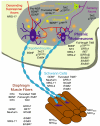Trophic factor expression in phrenic motor neurons
- PMID: 18708170
- PMCID: PMC2642900
- DOI: 10.1016/j.resp.2008.07.018
Trophic factor expression in phrenic motor neurons
Abstract
The function of a motor neuron and the muscle fibers it innervates (i.e., a motor unit) determines neuromotor output. Unlike other skeletal muscles, respiratory muscles (e.g., the diaphragm, DIAm) must function from birth onwards in sustaining ventilation. DIAm motor units are capable of both ventilatory and non-ventilatory behaviors, including expulsive behaviors important for airway clearance. There is significant diversity in motor unit properties across different types of motor units in the DIAm. The mechanisms underlying the development and maintenance of motor unit diversity in respiratory muscles (including the DIAm) are not well understood. Recent studies suggest that trophic factor influences contribute to this diversity. Remarkably little is known about the expression of trophic factors and their receptors in phrenic motor neurons. This review will focus on the contribution of trophic factors to the establishment and maintenance of motor unit diversity in the DIAm, during development and in response to injury or disease.
Figures

Similar articles
-
Diaphragm neuromuscular transmission failure in aged rats.J Neurophysiol. 2019 Jul 1;122(1):93-104. doi: 10.1152/jn.00061.2019. Epub 2019 May 1. J Neurophysiol. 2019. PMID: 31042426 Free PMC article.
-
Size-dependent differences in mitochondrial volume density in phrenic motor neurons.J Appl Physiol (1985). 2023 Jun 1;134(6):1332-1340. doi: 10.1152/japplphysiol.00021.2023. Epub 2023 Apr 6. J Appl Physiol (1985). 2023. PMID: 37022966 Free PMC article.
-
Invited review: Mechanisms underlying motor unit plasticity in the respiratory system.J Appl Physiol (1985). 2003 Mar;94(3):1230-41. doi: 10.1152/japplphysiol.01120.2002. J Appl Physiol (1985). 2003. PMID: 12571144 Review.
-
Phrenic motor unit recruitment during ventilatory and non-ventilatory behaviors.Respir Physiol Neurobiol. 2011 Oct 15;179(1):57-63. doi: 10.1016/j.resp.2011.06.028. Epub 2011 Jul 6. Respir Physiol Neurobiol. 2011. PMID: 21763470 Free PMC article. Review.
-
Mechanisms of compensatory plasticity for respiratory motor neuron death.Respir Physiol Neurobiol. 2019 Jul;265:32-39. doi: 10.1016/j.resp.2019.01.001. Epub 2019 Jan 6. Respir Physiol Neurobiol. 2019. PMID: 30625378 Free PMC article. Review.
Cited by
-
Systems biology of skeletal muscle: fiber type as an organizing principle.Wiley Interdiscip Rev Syst Biol Med. 2012 Sep-Oct;4(5):457-73. doi: 10.1002/wsbm.1184. Epub 2012 Jul 18. Wiley Interdiscip Rev Syst Biol Med. 2012. PMID: 22811254 Free PMC article. Review.
-
Inhibition of TrkB kinase activity impairs transdiaphragmatic pressure generation.J Appl Physiol (1985). 2020 Feb 1;128(2):338-344. doi: 10.1152/japplphysiol.00564.2019. Epub 2020 Jan 16. J Appl Physiol (1985). 2020. PMID: 31944892 Free PMC article.
-
Respiratory muscle plasticity.Compr Physiol. 2012 Apr;2(2):1441-62. doi: 10.1002/cphy.c110050. Compr Physiol. 2012. PMID: 23798306 Free PMC article. Review.
-
TrkB kinase activity maintains synaptic function and structural integrity at adult neuromuscular junctions.J Appl Physiol (1985). 2014 Oct 15;117(8):910-20. doi: 10.1152/japplphysiol.01386.2013. Epub 2014 Aug 28. J Appl Physiol (1985). 2014. PMID: 25170066 Free PMC article.
-
Differences in lumbar motor neuron pruning in an animal model of early onset spasticity.J Neurophysiol. 2018 Aug 1;120(2):601-609. doi: 10.1152/jn.00186.2018. Epub 2018 May 2. J Neurophysiol. 2018. PMID: 29718808 Free PMC article.
References
-
- Baker-Herman TL, Fuller DD, Bavis RW, Zabka AG, Golder FJ, Doperalski NJ, Johnson RA, Watters JJ, Mitchell GS. BDNF is necessary and sufficient for spinal respiratory plasticity following intermittent hypoxia. Nat. Neurosci. 2004;7:48–55. - PubMed
-
- Baloh RH, Enomoto H, Johnson EM, Jr., Milbrandt J. The GDNF family ligands and receptors - implications for neural development. Curr. Opin. Neurobiol. 2000;10:103–110. - PubMed
-
- Barbacid M. The Trk family of neurotrophin receptors. J. Neurobiol. 1994;25:1386–1403. - PubMed
Publication types
MeSH terms
Substances
Grants and funding
LinkOut - more resources
Full Text Sources

